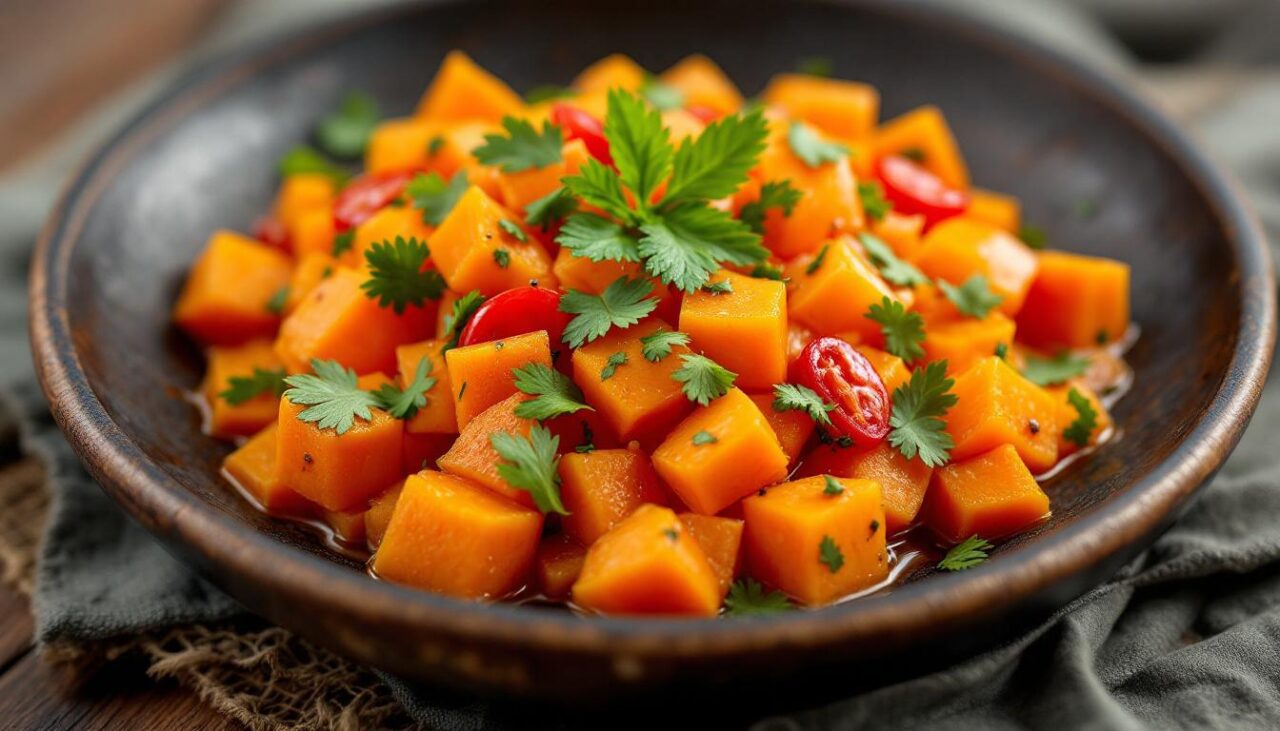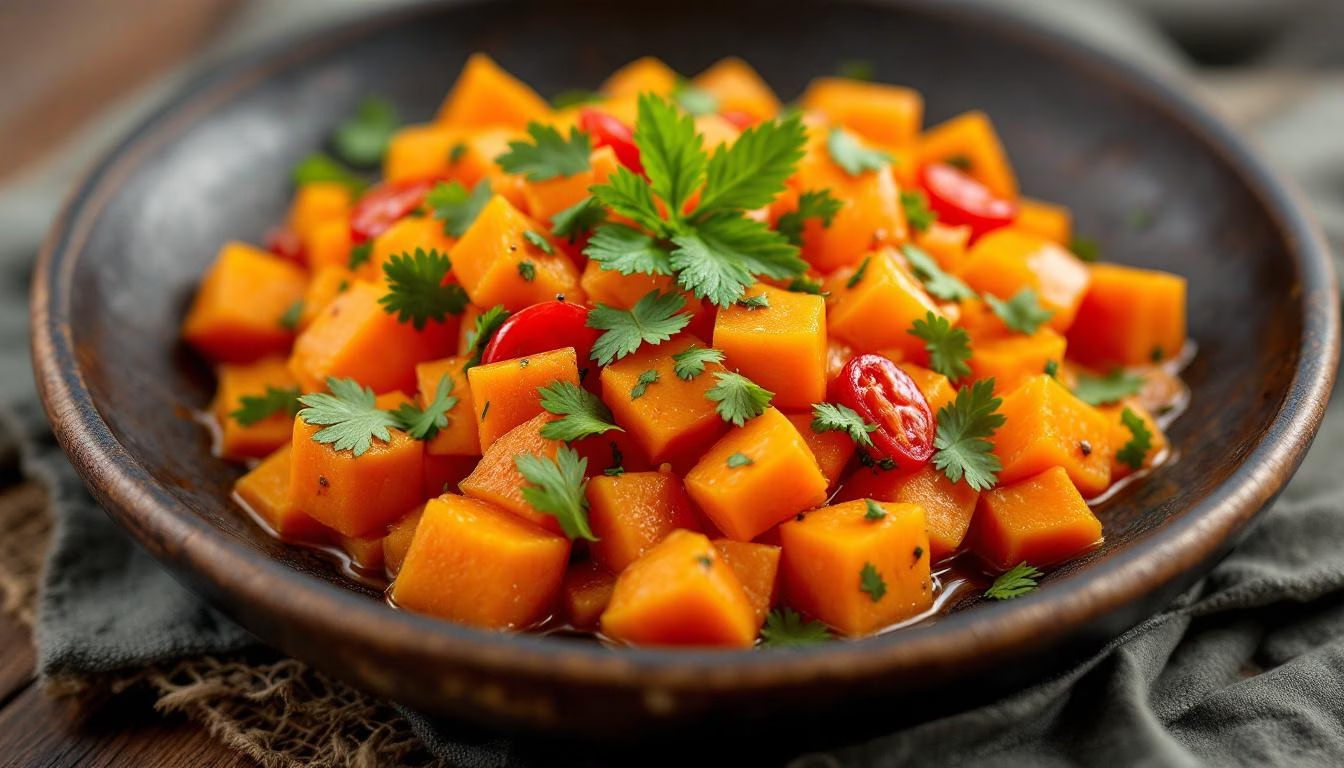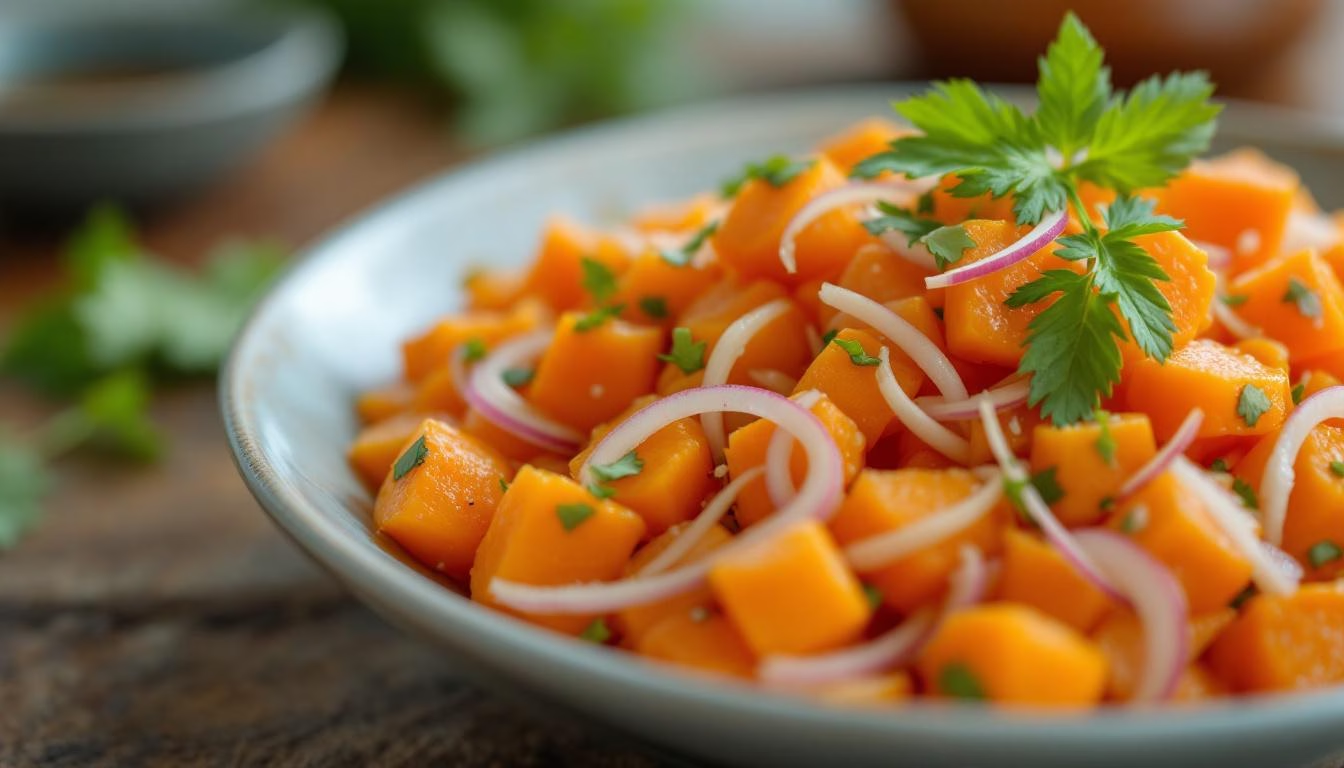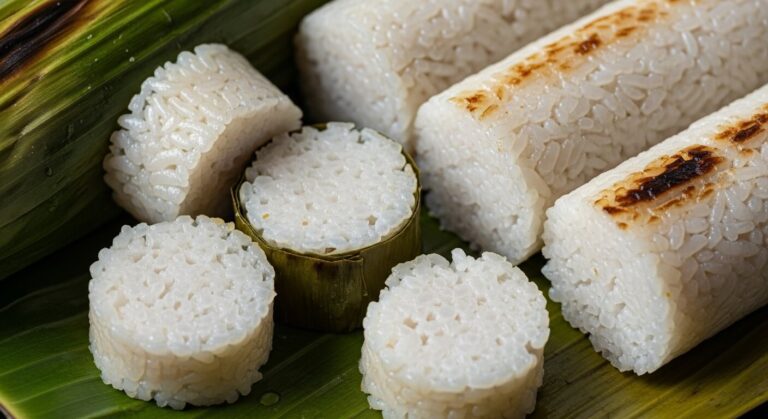Traditional Rujak Serut Recipe: Indonesian Shredded Salad
Indonesian Rujak Serut Recipe: The Ultimate Sweet Potato Salad – Last summer, I found myself wandering through a bustling Indonesian market in Queens, completely overwhelmed by the symphony of unfamiliar aromas and the vendors calling out in rapid-fire Indonesian.

Rujak Serut (Indonesian Sweet Potato Salad)
Ingredients
- 1 cup jicama (peeled and julienne cut)
- 1 cup sweet potato (peeled and julienne cut, or grated)
- 1 cup green mango (peeled and julienne cut)
- 1 cup pineapple (skinned and diced small)
- ½ cup pomegranate seeds ((optional))
- 2 tablespoons tamarind concentrate
- 1 tablespoon lime juice
- 1 tablespoon palm sugar (coconut sugar, or brown sugar)
- 3 bird’s eye chilies (thinly sliced)
- ½ teaspoon salt
- Mint leaves
- Cilantro leaves
Instructions
- In a large bowl, combine the julienned or grated jicama, sweet potato, green mango, diced pineapple, and, if using, pomegranate seeds.
- In a separate bowl, mix tamarind concentrate, lime juice, palm sugar, coconut sugar, brown sugar, thinly sliced bird’s eye chilies, and salt, stirring until the sugar is completely dissolved.
- Pour the dressing over the salad and toss thoroughly to coat evenly.
- If desired, garnish with mint leaves and cilantro leaves.
Nutrition
I was supposed to be picking up ingredients for a dinner party that evening, but instead, I kept getting distracted by every colorful display.
That’s when I spotted an elderly woman behind a small cart, methodically julienning what looked like a rainbow of vegetables and fruits with the kind of knife skills that made my amateur attempts look like a toddler with safety scissors.
She was making rujak serut, though I didn’t know it at the time.
I watched, mesmerized, as she transformed ordinary sweet potatoes, green mangoes, and jicama into perfect matchstick strips, then tossed everything with a dressing that smelled like sunshine and spice had a baby.
When she handed me a small cup to try, I nearly dropped it in shock—not because it was bad, but because it was so unexpectedly perfect.
Sweet, sour, spicy, and refreshing all at once, with textures that ranged from crisp to tender, it was like eating a tropical thunderstorm in the best possible way.
I stood there for probably ten minutes, pestering this patient woman with questions about every ingredient while she smiled and nodded, occasionally switching to broken English to explain that yes, the sweet potato was indeed raw (mind blown), and no, I couldn’t substitute regular sugar for palm sugar if I wanted it to taste right.
By the time I left, I had a crumpled piece of paper with her rough recipe scribbled in a mix of Indonesian and English, and a burning desire to recreate this Rujak Serut (Indonesian Sweet Potato Salad) recipe in my own kitchen.
Authentic Rujak Serut Recipe with Raw Sweet Potato
Rujak serut belongs to the wonderful world of Indonesian rujak—fresh fruit and vegetable salads that celebrate the perfect balance of sweet, sour, salty, and spicy flavors that Indonesian cuisine does so brilliantly.
The word “serut” means “shredded” or “grated,” which perfectly describes the technique that transforms ordinary ingredients into something magical.
Unlike the heavier, mayo-based salads we’re used to in Western cuisine, this Rujak Serut (Indonesian Sweet Potato Salad) recipe is all about showcasing the natural flavors and textures of fresh ingredients.
The dressing is light but punchy, made with tamarind concentrate that brings that distinctive sour-sweet flavor, lime juice for brightness, palm sugar for depth, and bird’s eye chilies for just enough heat to wake up your taste buds without setting your mouth on fire.
What surprised me most about this dish was learning that the sweet potato is served completely raw.
I know, I know—it sounds weird if you’re not used to it, but trust me on this one.
Raw sweet potato has this amazing crisp texture and subtle sweetness that works perfectly with the other ingredients.
It’s like discovering that carrots can be eaten raw all over again, except somehow more revelatory.
Essential Ingredients and Preparation
The beauty of this Rujak Serut (Indonesian Sweet Potato Salad) recipe lies in its simplicity, but don’t let that fool you—each ingredient plays a crucial role in creating the final harmony of flavors and textures.
The Star Players
Sweet potato forms the backbone of this salad, and yes, we’re using it raw.
Choose firm, fresh sweet potatoes with smooth skin—avoid any that feel soft or have dark spots.
When you julienne or grate them, they should feel crisp and snap cleanly.
If your sweet potato feels at all mushy, it’s past its prime for this recipe.
Jicama brings that satisfying crunch that makes this salad so addictive.
If you’ve never worked with jicama before, it’s like a cross between an apple and a water chestnut—mild, slightly sweet, and incredibly refreshing.
Peel it thoroughly (the skin can be tough and fibrous) and cut it into matchsticks about the same size as your sweet potato pieces.
Green mango is where things get interesting.
You want unripe mango that’s still firm and tart—not the soft, sweet mangoes you’d eat for dessert.
Asian markets are your best bet for finding these, though some regular grocery stores carry them in their international sections.
The green mango adds a bright, almost citrusy tartness that balances the sweetness of the other ingredients.
The Supporting Cast
Pineapple brings natural sweetness and tropical flair, but don’t go overboard—you want small dice, not chunks that will overwhelm the delicate balance.
Fresh pineapple is non-negotiable here; canned just won’t give you the right texture or flavor.
Pomegranate seeds are technically optional, but I highly recommend them.
They add gorgeous color and little bursts of sweet-tart flavor that complement the dressing beautifully.
Plus, they make the salad look like it belongs on the cover of a food magazine.
The Dressing Magic
Tamarind concentrate is the secret weapon in this Rujak Serut (Indonesian Sweet Potato Salad) recipe.
It’s what gives the dressing that distinctive sweet-sour flavor that you just can’t replicate with anything else.
You can find it in Asian markets, usually in small plastic containers or jars.
A little goes a long way, so don’t worry if the container seems small.
Palm sugar (also called coconut sugar) has a more complex, molasses-like flavor than regular white sugar.
If you can’t find it, brown sugar works in a pinch, but the flavor won’t be quite as authentic.
Bird’s eye chilies are tiny but mighty—use them sparingly unless you’re a serious heat lover.
If you can’t find them, Thai chilies or even a small amount of serrano pepper will work, though the flavor profile will be slightly different.
Step-by-Step Instructions
Making this Rujak Serut (Indonesian Sweet Potato Salad) recipe is surprisingly straightforward, but there are a few techniques that will make the difference between good and amazing.
Preparing Your Vegetables
Start by getting all your vegetables prepped and ready—this salad comes together quickly once you start mixing.
For the julienne cuts, aim for matchstick pieces about 2-3 inches long and roughly 1/8 inch thick.
Consistency matters here because you want every bite to have a good mix of all the ingredients.
If you’re nervous about your knife skills (and honestly, who isn’t when trying to create perfect matchsticks?), a mandoline slicer with a julienne attachment can be a game-changer.
Just watch your fingers—those things are sharp!
For the sweet potato specifically, work quickly once you’ve cut it.
While it won’t brown like apples, it can start to lose its crispness if it sits around too long.
If you need to prep it ahead of time, store the cut pieces in cold water, but drain and pat them dry before using.
Creating the Perfect Dressing
The dressing for this Rujak Serut (Indonesian Sweet Potato Salad) recipe needs to be mixed separately first—don’t just dump everything together and hope for the best.
Start by combining the tamarind concentrate and lime juice in a small bowl.
The tamarind can be pretty thick and paste-like, so whisking it with the lime juice first helps it distribute more evenly.
Add your palm sugar next and whisk until it’s completely dissolved.
This might take a minute or two of vigorous whisking, but it’s important—undissolved sugar crystals will give you an uneven flavor distribution.
Finally, stir in your sliced chilies and salt.
Taste the dressing at this point—it should be intensely flavored since it’s going to be diluted by all those vegetables.
You want a good balance of sweet, sour, and spicy, with the salt bringing everything together.
Bringing It All Together
Combine all your prepared vegetables and fruits in a large mixing bowl.
Pour the dressing over everything and toss thoroughly—and I mean thoroughly.
Use your hands if you need to; this isn’t the time to be precious about getting messy.
The key is making sure every piece of vegetable gets coated with dressing.
Unlike a green salad where you can get away with a light coating, this Rujak Serut (Indonesian Sweet Potato Salad) recipe needs every component to be well-dressed to achieve that perfect flavor balance.
Let the salad sit for about 5-10 minutes after mixing to allow the flavors to meld and the vegetables to absorb some of the dressing.
This brief resting period makes a noticeable difference in the final taste.
Pro Tips and Troubleshooting
After making this Rujak Serut (Indonesian Sweet Potato Salad) recipe countless times (and making plenty of mistakes along the way), I’ve learned a few tricks that will help you nail it on your first try.
Knife Skills Matter
Consistent cuts aren’t just about aesthetics—they ensure that every bite has the right ratio of ingredients.
If your sweet potato pieces are huge and your jicama pieces are tiny, you’ll get bites that are all sweet potato and others that are all jicama, instead of the harmonious blend you’re after.
If your knife skills aren’t quite there yet, don’t stress.
A food processor with a julienne disc can help, though you’ll need to be careful not to over-process everything into mush.
You want distinct pieces, not a slaw-like texture.
Balancing the Heat
Bird’s eye chilies can vary dramatically in heat level, even from the same plant.
Start with less than the recipe calls for, taste, and add more if needed.
Remember, you can always add heat, but you can’t take it away once it’s mixed in.
If you accidentally make it too spicy, adding a bit more palm sugar can help balance things out, though it won’t completely neutralize the heat.
A squeeze of extra lime juice can also help brighten things up and distract from excessive spiciness.
Storage and Serving
This salad is best served immediately after mixing, but it will keep in the refrigerator for up to 24 hours.
The vegetables will start to release their juices and soften slightly, which isn’t necessarily bad—just different.
Some people actually prefer the texture after it’s had a chance to marinate overnight.
If you’re making it ahead, wait to add the herbs until just before serving.
Mint and cilantro don’t hold up well once they’re dressed and will start to look sad and wilted after a few hours.
Creative Variations and Substitutions
While this traditional Rujak Serut (Indonesian Sweet Potato Salad) recipe is pretty perfect as written, there’s definitely room for creativity and adaptation based on what you can find or your personal preferences.
Fruit Variations
Green papaya makes an excellent substitute for green mango if you can’t find unripe mangoes.
It has a similar crisp texture and mild flavor that works beautifully with the dressing.
Just make sure it’s truly unripe—you want it firm and pale, not at all orange or soft.
Green apples, particularly Granny Smith, can work in a pinch, though they’ll add a different flavor profile.
Peel them and toss with a little lime juice to prevent browning.
If fresh pineapple isn’t available, you can use canned, but drain it thoroughly and rinse off the syrup.
The texture won’t be quite as crisp, but it’ll still add that tropical sweetness you’re looking for.
Vegetable Swaps
Carrots make a great addition or substitution for some of the sweet potato.
Use the large, mature carrots rather than baby carrots—they have better flavor and texture for this application.
Daikon radish adds a nice peppery bite if you want to amp up the complexity.
Use it sparingly though, as it can be quite assertive.
For those who can’t find jicama, water chestnuts (fresh, not canned) provide similar crunch, though the flavor is milder.
Dressing Adaptations
If tamarind concentrate is absolutely impossible to find, you can make a substitute by mixing rice vinegar with a small amount of brown sugar and a tiny pinch of ground ginger.
It won’t be exactly the same, but it’ll give you a similar sweet-sour profile.
For those who prefer less heat, you can substitute the bird’s eye chilies with a small amount of red pepper flakes or even a dash of hot sauce, though you’ll lose some of the fresh chile flavor.
What to Expect and Final Thoughts
The first time you make this Rujak Serut (Indonesian Sweet Potato Salad) recipe, you might be surprised by how different it tastes from any salad you’ve had before.
The combination of raw sweet potato with that tangy, spicy dressing is unlike anything in Western cuisine, and it might take your palate a moment to adjust.
Don’t be discouraged if your first attempt doesn’t taste exactly like what you might have had at a restaurant or market.
Indonesian cooks often adjust the seasoning by taste rather than following exact measurements, and factors like the ripeness of your fruit, the heat level of your chilies, and even the brand of tamarind concentrate can affect the final flavor.
The texture should be the star here—every bite should offer a satisfying mix of crisp, tender, and juicy elements.
If everything feels mushy, your vegetables might have been over-ripe or you might have let it sit too long after dressing.
If it seems too dry, you probably need more dressing.
This salad is incredibly refreshing and makes a perfect side dish for grilled meats or rich, coconut-heavy curries.
It’s also substantial enough to serve as a light lunch on its own, especially on hot summer days when you want something cooling but satisfying.
The beauty of mastering this Rujak Serut (Indonesian Sweet Potato Salad) recipe is that it opens the door to understanding the flavor principles that make Indonesian cuisine so compelling.
Once you get comfortable with the sweet-sour-spicy-salty balance, you’ll start seeing opportunities to apply these techniques to other dishes.
Most importantly, don’t be afraid to make it your own.
Indonesian cooking is all about balance and personal preference, so taste as you go and adjust accordingly.
That elderly woman in the Queens market probably never made it exactly the same way twice, and neither should you.








